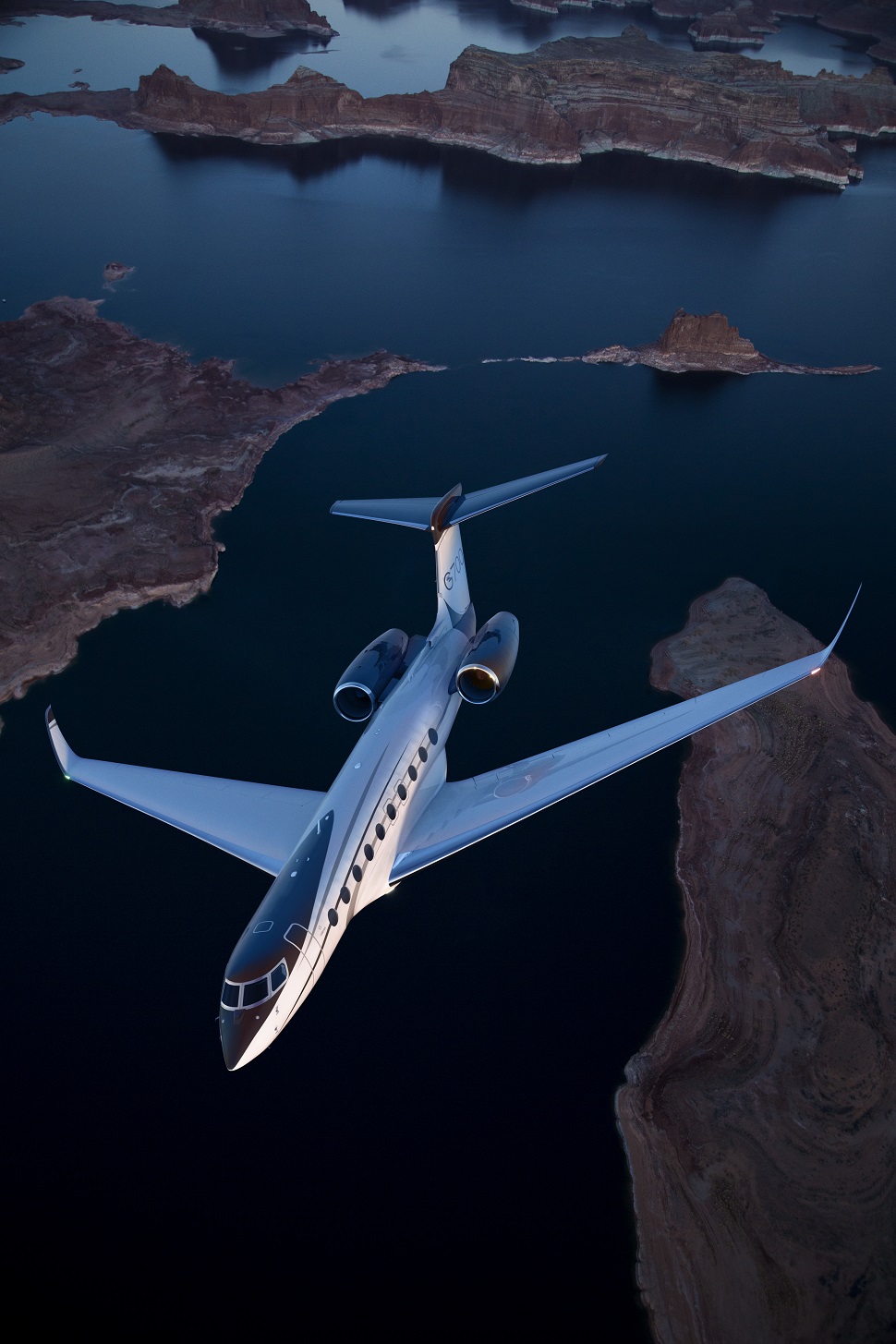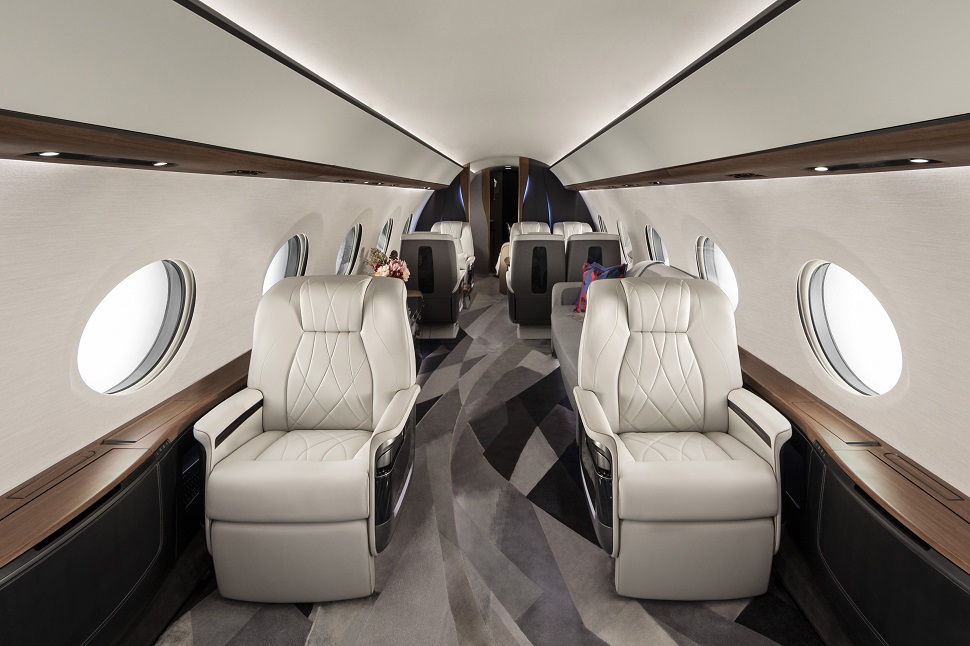Gulfstream rocked the business jet industry on 21 October with the launch of a new 19-passenger business jet called the G700 – a 7,500nm (13,900km)-range, Rolls-Royce Pearl 700-powered behemoth with specs that align closely with Bombardier's Global 7500.
Savannah-based Gulfstream, which announced the programme at the NBAA show in Las Vegas, has already begun the G700's test campaign and is working towards delivering the first aircraft in 2022.The company has a G700 cabin mock-up at the show.
"This will be a Mach 0.9 cruising machine that will travel all over the world… I think it's really going to take the industry by storm," said Gulfstream senior vice-president for innovation, engineering and flight Collin Miller.
The G700 will have "the longest, tallest, widest cabin" in the traditional business jet industry, he says.

A rendering of Gulfstream's planned G700, which it expects to start delivering in 2022
Gulfstream
Gulfstream expects the G700 to share a type rating with the company's recently-certificated G500 and G600. It will also share those models' cockpit technologies and flight systems.
"We [will] take the technology of the 500 and 600 and morph them into a much larger aircraft. That really starts to differentiate us," says Gulfstream president Mark Burns.
He describes the G700 as a response to customers, who Gulfstream says "want more cabin space".
"Our customers, at this point, are not asking for more range… but they want more space," adds Gulfstream senior vice-president of worldwide sales Scott Neal.
The aircraft will achieve its maximum range when flying at M0.85. At M0.9, the G700 will have a range of 6,400nm, which Burns says is more than 1,000nm more than competing aircraft at that speed. The G700 will have M0.925 maximum operating speed.
The G700 would compete primarily against Bombardier's 7500 in the ultra-long-range market. Direct range comparisons are difficult due to the differing operating specifications under which airframers measure aircraft performance, but Bombardier advertises the 7500, which entered service in 2018, as having 7,700nm range when flying at M0.85 with 12 people aboard.
The G700's range will match that of the G650ER. But the G700 will be bigger – nearly 33.5m (110ft) long, about 3m longer than the G650ER and about 0.3m shorter than the 7500, according to Gulfstream's and Bombardier's specifications.
The G700's cabin, excluding the baggage compartment, will be 17.4m long and 2.5m wide, while the 7500's cabin is 16.6m long and 2.4m wide. The G700 cabin will be 1.9m high – a fraction more than the 7500's cabin, according to manufacturers' specifications.

The G700 will be capable of carrying 19 passengers and sleeping 10 passengers
Gulfstream
The G700 will have five cabin areas, or four plus a crew rest area. It will have a forward galley, main cabin area with a 32in LCD television and 2m divan, dining area with a six-person table, and a master suite aft. It will have a lavatory and luggage area farther aft and will be able to sleep 10 people.
The G700 will also have Gulfstream's latest cabin control system, which passengers will be able to direct using mobile devices, and a "circadian lighting system that dynamically mimics sunrise to sunset", the company says.

The G700 will have a six-person dining/conference table embedded wireless mobile phone chargers
Gulfstream
Its cabin altitude will be 4,850ft at its maximum cruise altitude of 51,000ft, and the G700 will have a maximum takeoff weight of 48,800kg (107,600lb).
The G700's Pearl 700s turbofans are designed specifically for the aircraft and share the Pearl engine family's common core, says Gulfstream. The powerplants will have "blisk fans" – meaning the blades are integrated into the hub – 10-stage high-pressure compressors, new low-pressure systems and new nacelles, Gulfstream says.
Pearl 700s will produce up to 18,250lb (81.2kN) of thrust and burn 2-3% less fuel than the G650's R-R BR725s, and Gulfstream says the G700 will be capable of engine start to taxi in less than 10min, thanks largely to automation.
It will be capable of taking off from a 1,905m runway at maximum takeoff weight and of landing in 762m at a typical landing weight.
"The engine is a beast," says Miller. "It's not a bolt-on Pearl. It's specifically designed for this airplane."
Up front the G700 will have active control sidesticks and Honeywell's Primus Epic-based Symmetry flight deck, with touchscreen avionics, dual head-up displays, airport moving maps, hail and lightning prediction technology, synthetic and enhanced vision systems and a predictive landing system that helps warn pilots if they are flying an improper approach.
Gulfstream will outfit the G700 with a fly-by-wire flight control system and a data concentration network – a central hub that connects and shares data between systems and subsystems, according to Miller.
That system enables quick starts by automating steps normally performed by pilots.
"It's low work load," Miller says of flying the G700. "The cockpit was designed by pilots for pilots, and it's designed to follow the progression of steps you need to follow… for each phase of flight, from start up through shut down."
2019NBAA
Read all the latest news and information from the 2019 NBAA show on our dedicated page






















